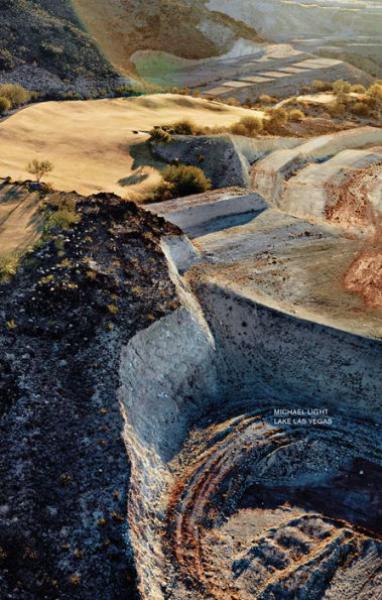Description
A harrowing overview of Nevada's post-recession real estate slump, Michael Light photographs half-finished luxury developments and the landscapes that were reshaped to accommodate them.--Phil Bicker "TIME Lightbox "
As in his other work, Light photographed the communities aerially, shooting out of a helicopter and, occasionally, a fixed-wing plane. He worked during the morning and late afternoon, when the light provided "maximum three-dimensionality." And, for the first time, he shot extensively in color, capturing a dizzying palette of golf-course greens and swimming-pool blues to highlight the artificiality of the manufactured landscape.
That overhead perspective allowed him to capture the way in which the developments, "practically airlifted" into the environment, stuck out from their surroundings. It also afforded him a view of places that would be off-limits from the ground. "They're guarded and gated and available only to property owners and their specified guests. That's one aspect of my aerial practice that I enjoy, which is to say that I can leap over the proverbial hedgerow and tell the story I want to tell," he said.--Jordan G Teicher "Slate "
Lake Las Vegas, the subject of Michael Light's aerial photographs in Lake Las Vegas/Black Mountain, is such an explicitly European fantasy that a replica of Florence's famous Ponte Vecchio bridge crosses a stretch of its artificial lake, and the houses are mostly in the stucco-and-tile-roof mode called "Mediterranean." From near the earth you see into yards and houses, terra cotta roofs, pieces fitting together like a puzzle, tight to each other, despite the expanse all around, or you see the texture of the earth that has been groomed and scraped and graded into something you can drop a mansion onto. From a little ways higher, you see the layout of the streets, like a fingerprint pressed into the landscape, the whorls and cul-de-sacs of the curvilinear layouts beloved of developers.--Rebecca Solnit "TomDisptach "
Light's aerial images of the terrain surrounding Las Vegas are both gorgeous and disturbing, showing the suburban sprawl from such heights that it looks like abstract art but reveals man-made havoc.--Jack Crager "American Photo "
Light's photography doesn't so much question the developers' summary as it does, say, blast it, scar it, terrace it and then build a large housing development on the remains. Featuring beautifully composed aerial shots of the construction sites and golf courses covering the desert, the book is a clear condemnation of the destructive and unsustainable development in Nevada. Much more than that, though, Light is highlighting a wider philosophy behind developments like Ascaya and Lake Las Vegas that fundamentally fail to connect American society with the American landscape in a non-destructive way.--Dario Goodwin "Arch Daily "
Product Details
- Radius Books Brand
- May 26, 2015 Pub Date:
- 1934435856 ISBN-10:
- 9781934435854 ISBN-13:
- 70 Pages
- 16.4 in * 10.6 in * 1 in Dimensions:
- 4 lb Weight:




